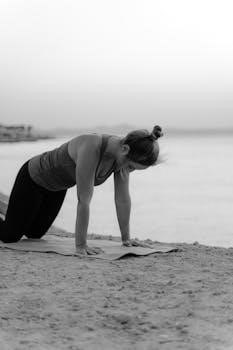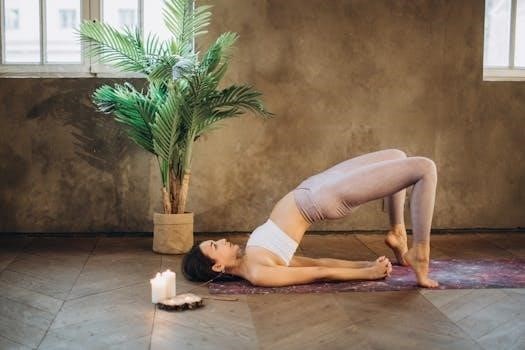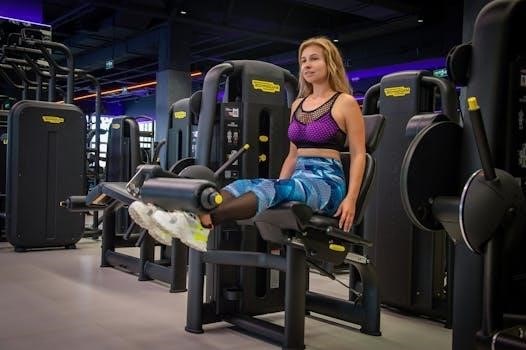quadricep strengthening exercises pdf

Quadriceps strengthening is crucial for overall lower body power, knee stability, and injury prevention. Strong quads enhance performance in activities like running, jumping, and lifting. This guide explores essential exercises for building robust quadriceps muscles.

Importance of Strong Quadriceps
Strong quadriceps muscles are vital for numerous reasons beyond aesthetics. They play a key role in supporting the knee joint, reducing the risk of injuries such as ACL tears and patellofemoral pain syndrome. Well-developed quads contribute to improved performance in various sports and daily activities, including walking, running, and jumping. Furthermore, they enhance the stability required for compound lifts like squats and lunges. Strengthening the quadriceps helps with knee tightness and improves overall lower body function. The quadriceps are a powerhouse, particularly for women, and contribute to improved balance and stability. Ultimately, strong quads are essential for both athletic performance and overall health.
Basic Quadriceps Exercises
These exercises are foundational for building quad strength. They are often used in rehabilitation and are ideal for beginners. They include straight leg raises, short arc quads and wall slides.
Straight Leg Raises
Begin by lying on your back on a flat surface. Keep one leg straight and the other bent with your foot flat on the floor. Tighten the quadriceps muscle of your straight leg and slowly raise it a few inches off the ground, keeping it straight. Hold for a few seconds, then lower it back down in a controlled manner. This exercise targets the quadriceps, helping to improve strength and stability. It is a good starting point for those with weak or injured quads. Repeat for 10-15 repetitions on each leg.
Short Arc Quads
To perform Short Arc Quads, begin by lying on your back with a small rolled towel or cushion placed under your knee. The heel of your foot is on the bed. Tighten the quadriceps muscle on the front of your thigh and slowly lift your foot off the bed, extending your knee. Hold the position for a few seconds, then slowly lower your foot back down to the bed. This exercise focuses on the terminal range of knee extension and is particularly beneficial for those with knee pain or limited range of motion. It enhances quadriceps activation and stability around the knee joint. Repeat 10-15 times on each leg.
Wall Slides
Wall slides are an excellent exercise for strengthening the quadriceps while also promoting knee joint mobility. To perform a wall slide, stand with your back against a wall, feet shoulder-width apart and slightly away from the wall. Slowly slide down the wall, bending your knees while keeping your back and head in contact with the wall. Lower yourself as far as comfortable without causing pain or strain, aiming for a 90 degree angle at the knees. Once you reach a comfortable depth, slowly slide back up to the starting position. Focus on controlled movement throughout the exercise. Repeat 10-15 times.
Intermediate Quadriceps Exercises
These exercises build on basic movements, adding intensity to further develop quad strength. They include step-ups and split squats, requiring more balance and muscle engagement.
Step-Ups
Step-ups are an excellent intermediate exercise targeting the quadriceps, glutes, and hamstrings. To perform a step-up, place one foot firmly on a stable elevated platform, such as a step or box. Ensure your knee is aligned with your foot and push through your heel to lift your body onto the platform. Slowly lower the other leg back to the floor, maintaining control. This exercise improves lower body strength, balance, and coordination. Focus on a controlled movement throughout the exercise. You can increase difficulty by using a higher platform. Begin with 3 sets of 10-12 reps for each leg.
Split Squats
Split squats are a highly effective intermediate exercise for quadriceps development, also engaging the glutes and hamstrings. Begin by standing with one foot forward and the other slightly behind, like a lunge position. Lower your back knee towards the floor, ensuring your front knee tracks over your toes. Maintain an upright torso and push back up to the starting position. This exercise improves single-leg strength, balance, and stability. Avoid letting your front knee extend past your toes. Start with 3 sets of 10-12 repetitions on each leg, focusing on controlled movements. For added challenge, use weights or dumbbells.
Advanced Quadriceps Exercises
Advanced exercises challenge the quadriceps with greater intensity, promoting further strength and muscle growth. These exercises often involve heavier loads or more complex movements, requiring good form and control.
Squats (various types)
Squats are a cornerstone exercise for quadriceps development, engaging multiple muscle groups. Variations like back squats, front squats, and goblet squats target the quads differently. The depth of the squat impacts quad activation, with deeper squats often leading to greater engagement. Emphasize knee tracking over the toes to maximize quad involvement. Adjust foot placement, using a plate or slant board to raise the heel, if ankle mobility is a limiting factor; Proper form is key, focusing on controlled movements and maintaining an upright posture, and will give you stronger legs.
Lunges (various types)
Lunges are highly effective for strengthening the quadriceps, offering variations to target different aspects of the muscle. Forward lunges, reverse lunges, and walking lunges each provide unique challenges. Ensure proper knee alignment, preventing it from caving inward. Focus on a controlled descent and a powerful push-off. The depth of the lunge influences the degree of quad activation, but avoid going too deep if it causes pain. Keep the torso upright, and maintain balance. Lunges improve stability, balance, and functional strength, and help with quad tightness.

Leg Press
The leg press machine is a valuable tool for advanced quadriceps strengthening. Foot placement on the platform plays a key role, with lower positioning increasing knee flexion and quad involvement. Push through your heels, maintaining a controlled movement. Avoid locking your knees at the top of the movement. The leg press allows for heavier loads and is useful for muscle hypertrophy. It should be done with proper form to avoid injuries. Ensure your feet are flat on the platform. You should aim for a full range of motion, moving through a full extension of the knee.
Proper Form and Technique
Maintaining correct form is essential for maximizing effectiveness and preventing injuries. Proper knee alignment and foot placement are key. Focus on controlled movements throughout each exercise, especially during knee extension.
Knee Alignment

Correct knee alignment is paramount during quadriceps exercises to prevent injury and maximize muscle engagement. The knee should ideally track directly over the toes, avoiding inward or outward deviation. This ensures the quadriceps muscles are the primary movers, rather than other supporting muscles. When performing exercises like squats or lunges, focus on maintaining this alignment throughout the movement. If you find that your knees are collapsing inward, consider reducing the range of motion or consulting with a physical therapist. Proper alignment not only protects your knee joint, but it also enhances the effectiveness of your quad-strengthening workout.
Foot Placement
Foot placement significantly impacts quadriceps activation during exercises. For exercises like squats and lunges, maintain a shoulder-width stance with feet pointing slightly outward. This provides a stable base and allows for optimal knee tracking. In leg press exercises, placing your feet lower on the footpad increases knee flexion, thus emphasizing the quads. Adjusting foot position can shift the focus to different parts of the quadriceps. Experiment with slight variations to find what feels best and targets your quads effectively. Always ensure your feet are flat on the ground or platform for maximum stability and proper execution during each exercise.
Training Considerations
Effective quadriceps training requires careful planning. Consider training frequency and volume, aiming for at least ten sets per week. Track your progress and adjust your routine to avoid plateaus.
Frequency and Volume
For optimal quadriceps development, aim to train this muscle group at least twice per week, allowing sufficient recovery time between sessions. Muscle growth is directly related to training volume, so incorporate at least ten sets per muscle group per week to stimulate hypertrophy. A minimum of five sets per workout, using a rep range of 8-12, is generally recommended for muscle growth. Adjust frequency and volume based on your fitness level and recovery capacity, ensuring adequate rest to maximize results and prevent overtraining. Remember to listen to your body and adjust accordingly.

Progression and Monitoring
Progressing effectively involves gradually increasing the intensity, volume, or difficulty of your quadriceps exercises over time. Start with basic exercises and slowly advance to more challenging variations, such as weighted squats or lunges, as your strength improves. Closely monitor your body’s response to training, noting any pain, fatigue, or discomfort. Ensure you maintain proper form throughout each exercise to maximize effectiveness and minimize injury risk. Consider using a training log or app to track your progress and make necessary adjustments. Consistent monitoring allows for a tailored approach, helping you reach your quadriceps strengthening goals safely and efficiently.